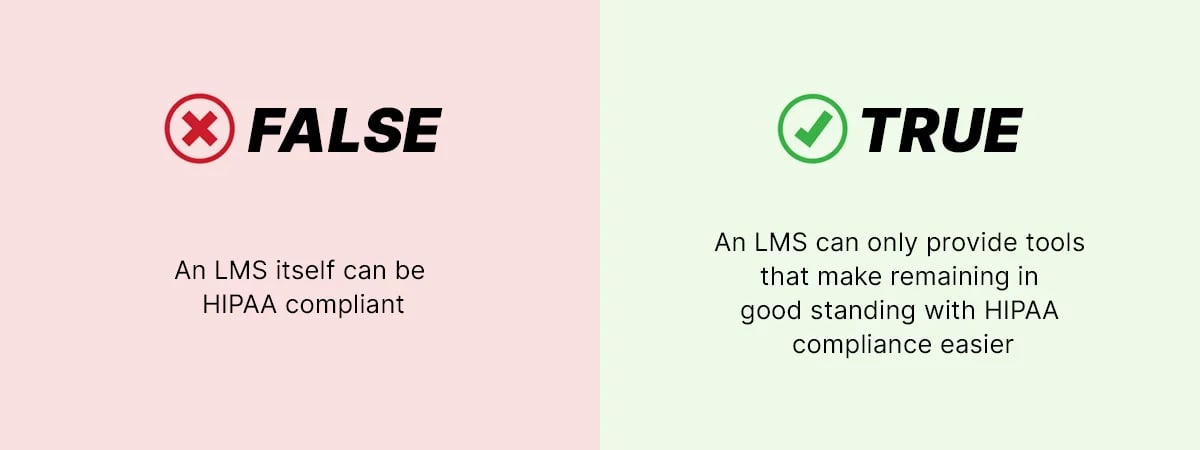3 to 5 years
how long you’ll likely end up using an LMS for
This guide will help you craft a strategic purchase plan that allows you to narrow your choices and find an LMS that’s best-suited for your organization.
Whether you’re shopping for your very first learning management system (LMS) or looking to upgrade, the process can be overwhelming. With so many vendor options, each with its own multitude of features and pricing structures, even the most seasoned educators, trainers, and business leaders can feel lost in a sea of choices.
Finding the right LMS for your organization requires a planned, strategic approach. This approach will help you avoid getting bogged down in the bells and whistles of features and flashy pricing and stay centered on what matters most.
And the key is finding the right LMS. Every organization is unique with specific needs and challenges that will dictate whether an LMS is right for them or not. Not only that but it’s estimated that once you purchase an LMS, you’ll likely end up using it for the next three to five years. So you’ll want to choose wisely.
Between customizing the platform to your needs, housing your entire learning program, and holding important data, you’ll probably build up a fair amount of resources in your LMS during this time. And migrating to a new platform may be challenging down the road if your current one doesn’t work out.
An LMS is also the key to your program's success. An ill-suited learning management system can lead to wasted resources, frustrated employees, and even hindered growth. Conversely, the right LMS can lead to increased employee retention, improved training effectiveness, and ultimately, a more competitive and successful organization.
how long you’ll likely end up using an LMS for
A learning management system is a long-term investment. And you’ll want to get it right from the start. But how can you be sure you’re picking the right LMS?
Picking the right LMS for your organization is a strategic decision that requires a thorough assessment of your immediate needs and long-term goals and vision. It also involves the right mix of non-negotiables proven by long-established LMS systems.
Oftentimes, poor LMS fit happens because organizations don’t define their needs deeply enough before meeting with LMS companies.
Coming prepared with a strategic plan is the most effective way to ensure you’re picking an LMS that is best suited to meet your needs.
We’ve put together a guide to help you easily create a strategic LMS purchasing plan. But, before you get started, keep in mind these two things.
To create a strategic plan, it all starts with you. You must first establish what you need. Every administrator – and organization – has a unique set of goals, requirements, and constraints. And these uniquenesses will serve as the ultimate guiding light in determining if an LMS is for you and your organization – or not.
However, keep in mind throughout this process that an LMS must be a good fit for you – and your learners. While you may be using the platform every day and may have certain needs, an LMS is equally important to your learners. Striking the right balance between the two is key.

Prioritize your – and your learners’ – must-haves and wants. Ask for input from all stakeholders from IT to HR, and department heads.
• • •
To start, outline your must-have features and wants. Your must-have features are your non-negotiables. Are video conferencing tools a must? What about version controls? Do you need certain e-commerce tools, payment processing options, or languages?
Also, consider your learners. What things would they like to see in an LMS? Is it social tools? How about certain engaging features? Are your learners struggling to fit training into their schedule? Then, maybe they need access to a mobile application.
Once you nail down your and your learner must-haves, create a wishlist. These are features that you wish an LMS vendor had, but it’s not a dealbreaker if they don’t. Maybe it’s virtual reality capability, certain automation features, branding requirements, customization needs, or specific reporting tools.
It can be helpful to gather stakeholder input during this process. You may even want to form some sort of committee to solicit feedback. Involve trainers, administrators, different department decision-makers, IT personnel, and, of course, your learners.
Depending on the provider, other departments in your organization may be able to leverage your LMS for their needs like sales enablement or partner training. By using your LMS, you can reduce costs and streamline organizational operations.
Ask stakeholders for input on any challenges or requirements they may have. And survey your learners, asking what they care most about when it comes to learning as well as their likes and dislikes if they’ve previously used an LMS.
When creating your list, make sure it goes beyond just bullet points. Include as many details as possible. These details will be helpful for giving LMS companies a good sense of what you’re looking to accomplish and evaluating them against how well they can achieve these things.


There are certain features that make for the best LMSs. Without these, you risk purchasing an imbalanced LMS. Consider including them in your strategic plan.
• • •
While every organization is unique and may need certain features, there are universal characteristics that have been tried and tested amongst millions of learners and administrators and have stood the test of time.
These elements are another metric by which you should consider if an LMS is or is not worth the cost. Without these qualities, you risk having an underperforming system and an imbalanced learning program. And we recommend not compromising in these areas.
When forming your purchasing strategy, also consider including the following LMS fundamentals as priorities and evaluating vendors against them.
| • Easy-to-use | • Security |
| • Engaging, interactive features | • Robust reporting and analytics |
| • Integrations | • Compliance |
An easy-to-use system that has a user-friendly interface can make all the difference in the world when it comes to learning and development. The last thing you want to do is go through the process of purchasing an LMS and then find out it is difficult to use.
Before purchasing an LMS, you’ll want to know it's a system that’s easy for you and your learners to use. Knowing these things upfront will save you a lot of headache and money down the road. But how can you tell if an LMS is simple just by looking at it, especially if each LMS varies so much?
Ask yourself, and your vendor, these key questions:
Course creations are, of course, the bread and butter of learning and development, so the easier they are to create, the better. Not all platforms include course creation capabilities, which means you’d have to use a third-party platform to create courses and then spend time importing them into the LMS, so you’ll want to make sure that the LMS has course creation tools first.
Then, you’ll want to evaluate the ease of using these course authoring tools. Easy-to-use content tools are great because they eliminate the need for coding. And similarly, you’ll want to see what it’s like to update courses. Mistakes happen and courses will need to be adjusted at times with new information. An LMS that allows you to do this easily is a great benefit to have.
Other things to look out for are quick-view reporting or leaderboards that allow you to see completion rates at a glance. An LMS may have data capabilities, and even robust ones at that, but accessing that data can be challenging. You don’t want to need to pull reports every time you want to see completion rates. These features will save you a ton of time and energy.
Additionally, you’ll want to think through your learner experience. Platforms with simple-to-use interfaces tend to experience higher levels of employee engagement and completion rates. When a platform is easy to navigate and understand, employees are more likely to proactively seek out training, resulting in a more motivated – and skilled – workforce.

Ultimately, a learning management system is only as valuable as it is engaging. You may have the most beautiful courses and easy-to-use admin experience, but if your learners are not engaged, then your program will fall on deaf ears.
When it comes to learning management systems, you never want to compromise on engaging, interactive features. These features are the key to making training less of a chore for your learners – and you.
Interactive elements, such as gamified challenges, quizzes with immediate feedback, and multimedia content, make the learning process more enjoyable. When learners actively participate and have fun while learning, they're more motivated to engage with training materials. And they’re more likely to complete training.
Administrators also reap significant rewards from these features. Since gamified and interactive elements naturally lead to higher engagement and completion rates, instructors who leverage these items generally don’t need to put as much time and effort into ensuring their learners finish training.
Moreover, diverse content options, features, and training styles enable admins to cater to various learning styles, increasing engagement even more. When LMSs include tools for things like blended and social learning, instructors can mix together elements that capture all of their learners’ interests, making training even easier.
has been proven to increase learning engagement by as much as 85%!
Integrations are invaluable for a learning management system because they enable the system to seamlessly interact with other tools, software, and platforms that your organization uses. Essentially, integrations allow data and processes to flow smoothly between your LMS and other systems.
This reduces manual data entry and repetitive tasks, leading to increased efficiency and productivity. It also helps to create a unified experience for users. Learners and administrators can access various tools and resources without switching between multiple platforms, leading to a more seamless and user-friendly experience.
On top of that, this streamlined workflow ensures that data remains consistent across different systems. When a learner completes a course, for example, their progress can be automatically updated in other connected systems like CRM or HRIS software.
Additionally, integrations enable the creation of automated workflows. For instance, when a new employee joins the company, the integration between an LMS and HRIS software can automatically assign them relevant training courses.
Integrations are important. And you’ll want to make sure that the LMS company you choose has the right ones for your organization.
Native integrations are great because they make the process easy. But an Open API is just as good because it can help you connect to nearly anything and has increased customization options. It does, however, require an IT team, so it’s a must for you to have one in-house or the LMS vendor to provide one for an Open API option to work.
| Common integrations | |
|---|---|
| Content integrations | These integrations connect the LMS with external content repositories, libraries, or content providers, allowing learners and educators to access a wide range of educational materials beyond what the LMS itself offers. |
| Single sign-on (SSO) integrations | SSO integrations enable users to access the LMS and other systems using a single set of credentials. This simplifies the login process and enhances security by reducing the need for multiple usernames and passwords. |
| Analytics and reporting integrations | Even if an LMS already has its own analytics and reporting capabilities, being able to connect with more robust data modulators can be of great benefit. It can provide deeper insights into organizational trends and performance and aid in even better decision-making. |
| Communication integrations | Pre-built integrations with communication tools such as blogging or social learning features like social media capabilities, community boards, and more facilitate real-time interaction and collaboration among learners and educators. This enhances engagement and fosters a sense of community within the learning environment. |
| E-commerce integrations | E-commerce integrations enable organizations to sell courses or training content through their LMS. Payment gateway integrations handle transactions and manage enrollments. |
| HR and CRM integrations | Integrating your LMS with a human resources information system (HRIS) or customer relationship management (CRM) system such as Salesforce, Workday, BambooHR, and others allow for seamless user management, enabling automatic enrollment, data synchronization, and user profile updates. |
| Video conferencing integrations | Pre-built LMS integrations with video conferencing tools like Zoom and Google Meet allow for live virtual classroom sessions, webinars, and events that reduce the need for third-party platforms, consolidating your tech stack and reducing costs. |
Fraud attacks and data breaches do happen – and not just to large organizations. Fraudsters target small businesses and local government agencies all the time knowing they are more likely to have weak or vulnerable areas in their system.
When it comes to LMS shopping, security and reliability are often an afterthought. Many organizations just assume an LMS is secure, but not all of them are. And with the average cost of a data breach for an organization around $4 million, it’s smart to consider the security of an LMS – not to mention its reliability – before moving forward with a purchase.
But how can you tell if an LMS is really secure and reliable?
the average cost of a data breach for an organization
A SOC 2 certification is the best way to tell if you are dealing with a secure LMS or not. SOC 2 stands for “Service Organization Control” and is conducted by a third-party, objective auditor who determines an organization’s system security, reliability, and data protection.
SOC 2 certification has two levels: Type 1 and Type 2. A SOC 2 Type 2 examination takes place over a longer period than a Type 1 audit (anywhere from six months to a year or more) and is more stringent.
While SOC 2 Type 1 is a good indicator of top-notch data security and reliability, a SOC 2 Type 2 certification is the highest level certification. At minimum, look for an LMS that meets SOC 2 Type 1 compliance but even better, look for an LMS that meets SOC 2 Type 2 compliance for the highest levels of system security, integrity, and reliability.
SOC 2 audits are entirely voluntary and since they require such a large amount of time, money, and resources, it shows an organization’s commitment to ensuring security and reliability for its customers.
A worthwhile LMS will prioritize security and reliability before anything else. They know that without security, they are leaving their customers in jeopardy. And when it comes to the learning management industry, a SOC 2 audit really is the only surefire way to ensure an LMS is secure and as reliable as it claims in your service level agreement.
Before moving forward with a purchase, think about any compliance regulations your organization may need to meet and even, your locations of operation. Not every organization will need to meet compliance requirements, but it’s always worth evaluating if yours does.
If you host learners located in certain regions, you may need an LMS that is compliant with the data protection laws of that area. And if you are subject to certain governmental compliances, an LMS can help you remain compliant.
One thing to note is that when it comes to certain compliance governmental regulations, like HIPAA for instance, an LMS can only aid your organization in compliance. The platform itself cannot be legally considered compliant. This is a huge misconception when it comes to compliant LMSs.
Essentially, for certain compliance regulations, an LMS can only provide you with tools and features that make remaining in good standing with compliance easier. Tools such as e-signatures, data reporting, and analytics tools make compliance easier and more streamlined.

HIPAA
Organizations may seek out an LMS to help support them in their effort to remain HIPAA-compliant. Though an LMS can drastically increase an organization’s chances of success, ultimate compliance responsibility will still remain with the organization purchasing an LMS.
An LMS that supports HIPAA compliance can only provide tools that make it easier to remain in good standing with compliance regulations. When shopping for a “HIPAA-compliant LMS,” ask your vendor what tools and features they have available that you can use to help aid in your compliance.
GDPR
GDPR stands for General Data Protection Regulation, and provisions the collecting, processing, or storing of personal data for individuals within the European Union (EU). If you operate within the EU, ask your LMS vendor if they are a GDPR-compliant LMS.
Organizations can be fined up to €20 million for non-compliance with GDPR regulations.
CCPA
The California Consumer Privacy Act (CCPA) is a privacy law that grants certain rights and protections to California residents regarding the collection, use, and disclosure of their personal information. If you operate in California, ask your LMS vendor if they are CCPA-compliant.
Compliance is another area that tends to get overlooked when people are shopping for LMSs. And misconceptions as well as misleading information can make it tricky. The best thing to do is think about your areas of operation and any compliance regulations your organization may be subject to and ask your vendor what tools they have available to help you meet these standards.

Draft one to three case studies for your most important needs, wants, or experiences, and have vendors walk you through them.
• • •
When you’re investing so much time and money into an LMS, it makes sense that you’d want it to fit your needs perfectly. While this may be true of some organizations – they’ve found an LMS that meets all their requirements – that’s not true for most.
Since every organization is different, it is difficult for an LMS to be everything to everybody. Even with the top LMS companies, you may need to compromise on one or two things. That’s not always the case. But that’s why it’s important to prioritize your needs and wants.
By creating a strategic plan and prioritizing your needs and wants, you’ll be able to know where you can and can’t cut back. And you can do a better comparison of LMS companies that fit correctly where you need it most.
Remember to start your strategic plan by listing your needs and wants. From there, consider the LMS essentials. Then, take all of them together and prioritize each. What matters to you most? And where are you willing to compromise? Describe these things in detail.
It can also be helpful to create one to three case studies based on your most important needs, wants, and experiences. For example, you may want to see how you can automate certificate delivery. Or maybe you want to see how you can enroll only learners in specific regions in certain courses. Again, list out these scenarios in detail.
After you’ve nailed down your list of non-negotiables, nice-to-haves, and case studies, evaluate how vendors respond. A lot of LMSs have the capability to do most things. But to what extent or how easily will vary dramatically. Some may be able to do what you need, but only if you purchase third-party tools. And others may require a complex process to accomplish it.
Be careful to evaluate these nuances and how the LMS performs.
To help even further with this process, we’ve included the top ten questions you should ask when evaluating vendors.
![]() 1. What other features do you have that my learners will love?
1. What other features do you have that my learners will love?
Learners love gamified and interactive content. But is there anything else they might like to see? How about awards and competition features? Or career development courses? Professional development has been proven to reduce employee turnover and increase job satisfaction. Take into consideration the totality of what your learners would love and evaluate vendors accordingly.
![]() 2. How can I cater to individual learner needs?
2. How can I cater to individual learner needs?
No two learners are alike, so training shouldn’t take a one-size-fits-all approach. Learners vary based on job title, region, prior knowledge, and even learning styles. Things like tailored learning paths allow you to take a targeted approach to learning, helping you cater to and address individual needs on a granular level.
![]() 3. Can you train multiple audiences?
3. Can you train multiple audiences?
You may begin by wanting to train just one audience. Maybe it’s just employees or customers. But over time, you may realize that you want to train both employees and customers and even certain departments or your partner channel. An LMS that allows you to easily add learners and provide unique login experiences to each can pay off dividends down the road.
![]() 4. How much of my training program can I automate?
4. How much of my training program can I automate?
Manual one-off and recurring tasks can add up. Imagine having to re-enroll learners every year for annual certifications. See if an LMS vendor can automate things like course enrollments, permission and access levels, notifications, reminders, and certificate delivery, increasing efficiency and accuracy and saving thousands of hours annually.
![]() 5. How configurable is your platform?
5. How configurable is your platform?
Configuration pertains to how customizable and adaptable an LMS is to your organization's unique structure, processes, and requirements for an efficient workflow. From design and branding to permission levels, and specific workflows, it’s important to evaluate if a vendor can match your unique requirements.
![]() 6. How will you support me before and after my launch?
6. How will you support me before and after my launch?
When it comes to LMS systems, customer support is just as important as the product. LMS systems can be complex and each has its own learning curve. You’ll require training to launch your program and ongoing support afterward. So robust onboarding and access to continued technical support is a must.
![]() 7. What additional services do you offer?
7. What additional services do you offer?
The value of an LMS provider often extends beyond its software. When evaluating solutions, you’ll also want to consider the other services a provider offers. By leveraging the right services, like course creation, design, and customization services, you can actually save money and resources in the long run, even if the provider charges for these add-ons.
![]() 8. How will your system adapt to my future needs?
8. How will your system adapt to my future needs?
Most businesses will expand over time – or at the very least, change. So it’s important to know if an LMS is equipped to evolve with you. Accordingly, you’ll need to know what to expect in terms of pricing and process when adding new learners. Ask if the LMS vendor charges per learner or by a flat rate and how easily you can add new learners.
![]() 9. How will your system adapt to changes in your own industry?
9. How will your system adapt to changes in your own industry?
You’ll want an LMS vendor that’s prepared for today – and tomorrow. Ask LMS providers if they do regular system upgrades to keep up with future and evolving industry trends in their own industry. Do they respond to client suggestions for new features? What about their current product roadmap? Do these things align with the current market climate?
![]() 10. Do you have a free trial?
10. Do you have a free trial?
A free trial gives you confidence in your decision to invest in a particular LMS. A trial allows you to base your decision on actual experience rather than relying solely on marketing materials or recommendations. Even if a vendor doesn’t advertise a free trial, always ask. A company that is transparent enough to let you see the system for yourself before you buy is one that’s worthwhile.
By spending a large portion of your time planning beforehand, you can save your organization a lot of money, resources, and energy down the road. You’ll be able to strategically and effectively evaluate learning management systems. And you’ll have something to keep you on track for what matters most.
This will prevent you from getting lost in the varying features and pricing of different vendors. And, most importantly, it will help you pick an LMS that is right for you, your learners, and your organization.
Founded in 2017, Tovuti is a cloud-based learning management system that delivers powerful training and educational content to over half a million learners worldwide. Businesses of all sizes trust Tovuti to educate their employees, customers, partners, and more, reducing churn and increasing ROI.
Increase training completion rates and ROI with a highly customizable, engaging LMS that makes learning fun and easy
Be the first to know about new B2B SaaS Marketing insights to build or refine your marketing function with the tools and knowledge of today’s industry.
© 2025 Tovuti LMS. All rights reserved.